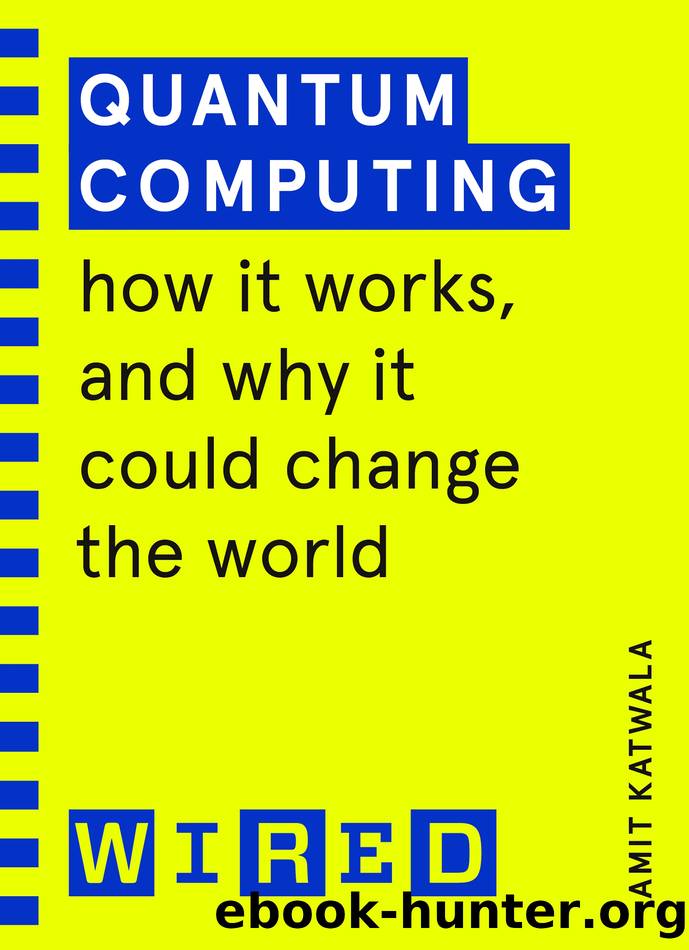Quantum Computing by Amit Katwala

Author:Amit Katwala [Katwala, Amit]
Language: eng
Format: epub
ISBN: 9781473585645
Publisher: Random House
Quantum internet
In August 2016, China sent the worldâs first quantum satellite into space from a launch pad in the Gobi Desert. Micius, which circles the earth at an altitude of 500 kilometres, is a powerful signal of intent â a starting gun for the technological race that could define the next century. Although it remains to be seen whether quantum computers will definitely be able to break new forms of encryption algorithm, scientists arenât taking a chance. With Micius, Chinese researchers are attempting to use a different type of quantum technology to develop new forms of secure communications that would be completely unbreakable.
Micius is being used for quantum key distribution, working on the principle that even an all-powerful quantum computer canât break a key it canât get access to in the first place. Itâs the latest in a long line of research that involves transmitting keys from sender to receiver using photons in a state of quantum superposition, so that itâs impossible to read them without changing what they say. If an attacker tries to intercept, the superposition will collapse into either 1 or 0 â leaving a telltale sign of tampering. With quantum key distribution, the message itself would still be transmitted using normal channels â itâs only the key that would be communicated using quantum technology.
In theory, this technology could underpin a global network of completely secure communication channels â a quantum internet of uncrackable messages, and a safe haven for governments fearful of Snowden-like leaks (or at least, for governments with enough money to throw at the problem). However, quantum communications face a problem: photons easily get absorbed or deflected by objects in the environment, which means that quantum keys can only be transmitted short distances without extra help. You canât easily ramp up the power of the signal, because a photon is the smallest possible unit of light â adding more would risk the signal being intercepted by an attacker siphoning off photons using mirrors without you noticing. Traditional communications networks use repeaters at stages along the route to boost the signal by copying it and retransmitting it, but again that doesnât work for quantum key distribution, because copying the message requires measuring it, which knocks photons out of superposition. Instead, rather than trying to pass on the signal while itâs still in superposition, itâs actually decrypted at each stage before being re-encoded into a new quantum state for the next leg of the journey.
However, this in turn opens up the seemingly unbreakable system to eavesdropping at the point where the message is unscrambled and re-encrypted. Researchers have been working to develop âquantum repeatersâ, which would allow the message to remain in superposition while still amplifying it. This technology has been demonstrated in theory, but working prototypes have proved more difficult to get right. Itâs also important to note that, just because the message itself is being sent via quantum mechanical means, it doesnât necessarily mean the entire system is unbreakable.
Charles Bennett, the IBM researcher whose
Download
This site does not store any files on its server. We only index and link to content provided by other sites. Please contact the content providers to delete copyright contents if any and email us, we'll remove relevant links or contents immediately.
| Automotive | Engineering |
| Transportation |
Whiskies Galore by Ian Buxton(41674)
Introduction to Aircraft Design (Cambridge Aerospace Series) by John P. Fielding(32984)
Small Unmanned Fixed-wing Aircraft Design by Andrew J. Keane Andras Sobester James P. Scanlan & András Sóbester & James P. Scanlan(32653)
Craft Beer for the Homebrewer by Michael Agnew(18041)
Turbulence by E. J. Noyes(7852)
The Complete Stick Figure Physics Tutorials by Allen Sarah(7228)
Kaplan MCAT General Chemistry Review by Kaplan(6761)
The Thirst by Nesbo Jo(6681)
Bad Blood by John Carreyrou(6429)
Modelling of Convective Heat and Mass Transfer in Rotating Flows by Igor V. Shevchuk(6324)
Learning SQL by Alan Beaulieu(6128)
Weapons of Math Destruction by Cathy O'Neil(6033)
Man-made Catastrophes and Risk Information Concealment by Dmitry Chernov & Didier Sornette(5836)
Digital Minimalism by Cal Newport;(5546)
Life 3.0: Being Human in the Age of Artificial Intelligence by Tegmark Max(5351)
iGen by Jean M. Twenge(5267)
Secrets of Antigravity Propulsion: Tesla, UFOs, and Classified Aerospace Technology by Ph.D. Paul A. Laviolette(5197)
Design of Trajectory Optimization Approach for Space Maneuver Vehicle Skip Entry Problems by Runqi Chai & Al Savvaris & Antonios Tsourdos & Senchun Chai(4927)
Electronic Devices & Circuits by Jacob Millman & Christos C. Halkias(4834)
